Enjoying the content on 3QD? Help keep us going by donating now.
Category: Recommended Reading
On Writing Advice and the People Who Give It
Sheila Heti at the Paris Review:
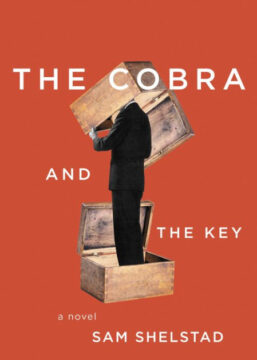 I think what confuses me so much about those who have prescriptions for how to write is that they assume all humans experience the world the same way. For instance, that we all think “conflict” is the most interesting and gripping part of life, and so we should all make conflict the heart of our fiction. Or that when we think of other people, we all think of what they look like. Or that we all believe things happen due to identifiable causes. Shouldn’t a writer be trained to pay attention to what they notice about life, what they think life is, and come up with ways of highlighting those things? The indifference to the unique relationship between the writer and their story (or between the writer and the reason they are writing), which is necessarily a by-product of any generalized writing advice, is part of what makes the comedy in this book so great. As a teacher, “Sam Shelstad” is so literal, and takes the conventions of how to write successful fiction on such faith, that when he tries to relay these tips to his reader, the advice ends up sounding as absurd as it actually is.
I think what confuses me so much about those who have prescriptions for how to write is that they assume all humans experience the world the same way. For instance, that we all think “conflict” is the most interesting and gripping part of life, and so we should all make conflict the heart of our fiction. Or that when we think of other people, we all think of what they look like. Or that we all believe things happen due to identifiable causes. Shouldn’t a writer be trained to pay attention to what they notice about life, what they think life is, and come up with ways of highlighting those things? The indifference to the unique relationship between the writer and their story (or between the writer and the reason they are writing), which is necessarily a by-product of any generalized writing advice, is part of what makes the comedy in this book so great. As a teacher, “Sam Shelstad” is so literal, and takes the conventions of how to write successful fiction on such faith, that when he tries to relay these tips to his reader, the advice ends up sounding as absurd as it actually is.
more here.
Enjoying the content on 3QD? Help keep us going by donating now.
Sunday, October 27, 2024
Old News? On Austria’s Freedom Party (FPÖ)
Lily Lynch in Sidecar:
Austria’s far-right Freedom Party (FPÖ) – the indirect successor to Austria’s National Socialist German Workers’ Party – used to generate apocalyptic headlines. Its successes were once treated as major news stories on both sides of the Atlantic, especially when the party was led by the telegenic Jörg Haider. A generational political talent, he led a campaign to force a referendum on restricting immigration in 1993 and pioneered a tanned, yuppy brand of right-wing politics that looks awfully familiar these days. Prior to Haider taking the helm in 1986, the FPÖ was a traditional bourgeois party dominated by decrepit Nazis and stodgy pan-German nationalists. But under his leadership, it was transformed into a modern populist outfit fuelled by xenophobia and entertainment. Haider, the New York Times magazine noted in 2000, ‘knows the glib, politics-as-pop-culture temper of his times’. ‘Europe, land of ghosts, is aghast.’
The Carinthian multi-millionaire was Austria’s wealthiest politician but styled himself a champion of the people, comfortable in the company of both the Viennese bourgeoisie and the clientele of rural beer halls. He poached support from the Socialist Party’s (SPÖ) traditional base with his economic populism, but was most successful with the middle class, who, in the years approaching the new millennium, feared losing jobs, status and state welfare as a result of immigration, European Union membership and globalization. The party’s dramatic metamorphosis under Haider was a spectacular electoral success, with results in the double digits and rising throughout the 90s. In 2000, having secured 27%, they entered government in coalition with the conservative Austrian People’s Party (ÖVP), upending the country’s post-war political consensus, which had been built on the joint dominance of the ÖVP and SPÖ.
More here.
Enjoying the content on 3QD? Help keep us going by donating now.
Gary Indiana, Acerbic Novelist and Critic, has Died Aged 74
Over at Frieze:
Gary Indiana, the novelist, playwright and critic who rose to prominence in the art world as a writer for the Village Voice in the 1980s, has died aged 74.
Born Gary Hoisington in Derry, New Hampshire in 1950, Indiana briefly studied at the University of California, Berkeley, before dropping out to pursue a career in ‘narrative porn’. After living among drug addicts in a rundown Los Angeles made famous by the fiction of Raymond Chandler, Indiana moved to New York City in 1978, where he became an actor and playwright in the downtown theatre and cinema scenes.
From 1985 to 1988, Indiana served as an acerbic, fearsome art critic for the Village Voice, at once elevating the underrated and skewering the well-established. His commentary was informed yet personal, and it drew an intense readership for his reflections on the political and social situation facing artists at the time. ‘I was lucky to have a public voice in those faraway days,’ he later recalled. ‘Of course, the primary task was to cover exhibitions, but much of the art being made in the ’80s deal with the world beyond four walls of a gallery, and it seemed perfectly natural to blend art criticism with commentary on the state of things.’
More here.
Enjoying the content on 3QD? Help keep us going by donating now.
Social Democracy After Class?
Bhaskar Sunkara in The Ideas Letter:
Can you build social democracy without workers? This question would have been unthinkable a few decades ago. Today, it captures a central challenge that left-of-center parties face around the world.
In the United States, even as the Democratic Party has moved leftward on both social and economic issues, it has less working-class support than ever. In 2020, Joe Biden lost non-college educated voters by 4 points. In a recent New York Times/Siena poll, Harris was trailing by 17 points. The shift in the party’s appeal is evident even among unionized workers. In 1992, Bill Clinton won that demographic by 30 points. In 2020, Biden beat Donald Trump by 19. In the latest forecasts, Harris’s advantage is just 9 points.
Similar shifts are in play across the advanced capitalist world, such as in Germany, where the socialist party Die Linke (the Left Party) went from receiving nearly one third of the vote in the country’s industrial eastern states in 2019 to barely registering as an electoral force there this year. Likewise, even though it is still in power, the Social Democratic Party has tended to fare poorly among workers, who are increasingly drawn to the far-right appeals of the Alternative for Germany: The AfD recently became the biggest group in Thuringia’s state parliament.
For decades, those still committed to a traditional social-democratic program have responded to this crisis of support with some combination of downplaying the problem, looking for substitutes for lost working-class voters, and trying to re-engage their former base by moving rightward on social issues. So far none of those answers has proved satisfactory.
More here.
Enjoying the content on 3QD? Help keep us going by donating now.
The Price is Wrong: Why Capitalism Won’t Save the Planet
Enjoying the content on 3QD? Help keep us going by donating now.
Four connections between Emily Dickinson and Franz Kafka
Jonmaas in Medium:
 At first, the poet Emily Dickinson and the novelist Franz Kafka might not seem connected. They are both influential writers to be sure, but beyond their general impact, the similarities seem to end. They wrote in different formats, addressed different themes, lived in different eras and geographic locations, and it is rare to hear them mentioned in the same breath.
At first, the poet Emily Dickinson and the novelist Franz Kafka might not seem connected. They are both influential writers to be sure, but beyond their general impact, the similarities seem to end. They wrote in different formats, addressed different themes, lived in different eras and geographic locations, and it is rare to hear them mentioned in the same breath.
It also seems that they did not influence one another. Dickinson lived before Kafka, and there isn’t a great deal of evidence that Kafka read Dickinson, let alone was impacted by her. Perhaps most importantly, these two writers engender different sentiments in their readers.
Dickinson’s poems bring joy, Kafka’s novellas illustrate alienation and despair―albeit the kind that brings insight to his readers, and perhaps even joy as well. If they were not connected by similarities of their prose, then they were bound by the threads of how they came to make their prose. And the last common thread might give insight into both the human condition — and the foundation of art itself.
More here.
Enjoying the content on 3QD? Help keep us going by donating now.
How a Play About A.I. Lured Robert Downey Jr. to Broadway
Alexandra Alter in The New York Times:
 This summer, Ayad Akhtar was struggling with the final scene of “McNeal,” his knotty and disorienting play about a Nobel Prize-winning author who uses artificial intelligence to write a novel. He wanted the title character, played by Robert Downey Jr. in his Broadway debut, to deliver a monologue that sounded like a computer wrote it. So Akhtar uploaded what he had written into ChatGPT, gave the program a list of words, and told it to produce a speech in the style of Shakespeare. The results were so compelling that he read the speech to the cast at the next rehearsal.
This summer, Ayad Akhtar was struggling with the final scene of “McNeal,” his knotty and disorienting play about a Nobel Prize-winning author who uses artificial intelligence to write a novel. He wanted the title character, played by Robert Downey Jr. in his Broadway debut, to deliver a monologue that sounded like a computer wrote it. So Akhtar uploaded what he had written into ChatGPT, gave the program a list of words, and told it to produce a speech in the style of Shakespeare. The results were so compelling that he read the speech to the cast at the next rehearsal.
“Their jaws dropped,” Akhtar said. “It had preserved the speech that I wrote, using those words in such fascinating ways that it was astonishing to everybody there.”
Ultimately, Akhtar used only two of the chatbot’s lines. But his attempt to mimic A.I.-generated text — an oddly circular process of a human imitating a computer’s imitation of a human — had an uncanny effect: Downey’s delivery of the final speech feels both intimate and strangely disembodied.
More here.
Enjoying the content on 3QD? Help keep us going by donating now.
Sunday Poem
Even the words that we are speaking now
thieving time
has stolen away,
and nothing can return,
—from the Odes or Horace
The Greatest Mystery
I stop and do nothing. Nothing happens.
I am thinking about nothing.
I listen to the passing of time.
This is time, familiar and intimate.
We are taken by it. The rush of seconds, hours, years
that hurls us toward life then drags us toward nothingness . . .
We inhabit time as fish live in water. Our being is in time.
It’s solemn music nurtures us, Opens the world to us,
Troubles us, frightens and lulls us.
The universe unfolds into time,
the events of the universe succeed each other
in an orderly way: pasts, presents, futures
—the past is fixed, the future open . . . And yet
all of this has turned out to be false,
the features of time have proved to be
approximations, like the flatness of earth
or a revolving sun . . .
by Carlo Rovelli
from The Order of Time
Riverhead Books, 2018
Enjoying the content on 3QD? Help keep us going by donating now.
Friday, October 25, 2024
Charles Taylor’s exploration of Romantic poetry
George Scialabba in Commonweal:
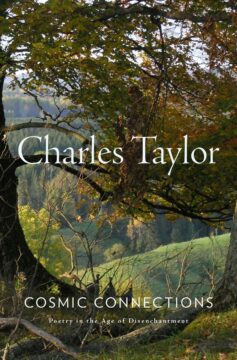 The passage from Enlightenment to Romanticism at the end of the eighteenth century was perhaps the most deeply felt crisis in European intellectual history. The Age of Reason had seen such extraordinary strides in scientific discovery and political liberty that the future progress of both mind and society seemed to many already marked out. Two groups of people were unhappy about this. Traditionalists, both religious and political, regarded the party of Reason as a nuisance, to be swatted away rather than argued with in earnest. The Enlightenment’s scientific materialism and anti-authoritarianism seemed to them sheer perversity, old heresies in a new garb. But by the time the party of Reason morphed into the party of Revolution, it was too late for swatting; and by the mid-nineteenth century the traditionalists had retreated into a long defensive crouch that lasted until quite recently.
The passage from Enlightenment to Romanticism at the end of the eighteenth century was perhaps the most deeply felt crisis in European intellectual history. The Age of Reason had seen such extraordinary strides in scientific discovery and political liberty that the future progress of both mind and society seemed to many already marked out. Two groups of people were unhappy about this. Traditionalists, both religious and political, regarded the party of Reason as a nuisance, to be swatted away rather than argued with in earnest. The Enlightenment’s scientific materialism and anti-authoritarianism seemed to them sheer perversity, old heresies in a new garb. But by the time the party of Reason morphed into the party of Revolution, it was too late for swatting; and by the mid-nineteenth century the traditionalists had retreated into a long defensive crouch that lasted until quite recently.
The Romantics’ quarrel with the Enlightenment was more intimate and impassioned. The Romantics embraced Enlightenment rationalism, as far as it went, but protested that it left many important questions unanswered. “Is that all?” the nineteenth century rebuked the eighteenth. “How does your Reason account for Spirit, Beauty, Community, Art? Why are Intuition and Imagination not equally valid sources of truth?”
More here.
Enjoying the content on 3QD? Help keep us going by donating now.
About Rwanda’s outbreak of Marburg virus
Carissa Wong in New Scientist:
 Beginning in late September, 62 cases and 15 deaths had been reported by 17 October, mostly among healthcare workers in Kigali, the capital city.
Beginning in late September, 62 cases and 15 deaths had been reported by 17 October, mostly among healthcare workers in Kigali, the capital city.
More than 800 contacts of infected people have been followed up in an effort to catch infections early and prevent further transmission, two of whom travelled to Belgium and Germany but were given the all-clear. As of October 21, no new cases or deaths had been reported in six days, but the threat of the outbreak hasn’t gone away.
Marburg virus is from the same family of viruses as those that cause Ebola, which are “among the most lethal pathogens known to infect humans”, according to a perspective article in The New England Journal of Medicine.
More here.
Enjoying the content on 3QD? Help keep us going by donating now.
This Theory of Everything Could Actually Work: Wolfram’s Hypergraphs
Enjoying the content on 3QD? Help keep us going by donating now.
On Loving America
Kelsey Klotz in The Common Reader:
 In May 2018, Childish Gambino (Donald Glover’s musical alter-ego) dropped the single “This Is America.” ¹ Critics generated think piece after think piece dedicated to analyzing the video, which was laden with visual symbolism, including references to Jim Crow, the 2015 Charleston Church massacre, police brutality, hip hop tropes, James Brown, and global Black dance moves. What started as a seemingly clear statement—“This Is America”—resulted in a myriad of perspectives as to what exactly America was for Donald Glover.
In May 2018, Childish Gambino (Donald Glover’s musical alter-ego) dropped the single “This Is America.” ¹ Critics generated think piece after think piece dedicated to analyzing the video, which was laden with visual symbolism, including references to Jim Crow, the 2015 Charleston Church massacre, police brutality, hip hop tropes, James Brown, and global Black dance moves. What started as a seemingly clear statement—“This Is America”—resulted in a myriad of perspectives as to what exactly America was for Donald Glover.
The song was popular immediately after its release, and it had a resurgence in the renewed Black Lives Matter protests following the killing of George Floyd. But the song came to my mind again after the January 6 riots at, and in, the United States Capitol Building. In the aftermath, politicians and others seemed to stumble over themselves, insisting one after the other that “this is not America.” It would seem they are correct: the United States boasts the longest-running continuous democracy in the world, and what the world witnessed at the Capitol—an extremist mob attempting to prevent by force the certification of election results—was fundamentally undemocratic. But amid those rushing to claim that “this was not America,” I (and so many others) wondered what America actually was, if not “this.”
More here.
Enjoying the content on 3QD? Help keep us going by donating now.
Letters by Oliver Sacks – sex and motorcycles
Ralf Webb in The Guardian:
 In 1960, Oliver Sacks, a 27-year-old University of Oxford graduate, arrived in San Francisco by Greyhound bus. Born in Cricklewood, London, Sacks spent the better part of his 20s training to be a doctor, but came to feel that English academic medicine was stifling and stratified. A “tight and tedious” professional ladder, he thought, was the only one available to aspiring neurologists like him.
In 1960, Oliver Sacks, a 27-year-old University of Oxford graduate, arrived in San Francisco by Greyhound bus. Born in Cricklewood, London, Sacks spent the better part of his 20s training to be a doctor, but came to feel that English academic medicine was stifling and stratified. A “tight and tedious” professional ladder, he thought, was the only one available to aspiring neurologists like him.
A young queer man with a growing interest in motorcycle leather, Sacks had other reasons to leave. The revelation of his sexuality had caused a family rift: his mother felt it made him an “abomination”. And so he looked for escape across the Atlantic. America, for him, was the wide open west of Ansel Adams photographs; California was Steinbeck’s Cannery Row. The new world promised “space, freedom, interstices in which I could live and work”. This is how we meet Oliver Sacks in Letters: as an immigrant undertaking an internship at Mount Zion hospital, the first step in a career on US soil that would span another five decades.
More here.
Enjoying the content on 3QD? Help keep us going by donating now.
Do stem-cell transplants increase cancer risk?
Smriti Mallapaty in Nature:
 Ever since the first blood-forming stem cells were successfully transplanted into people with blood cancers more than 50 years ago, researchers have wondered whether they developed cancer-causing mutations. A unique study1 on the longest-lived transplant recipients and their donors has revealed that people who receive donor stem cells don’t seem to have an increased risk of developing such mutations. The results are surprising but reassuring, says Michael Spencer Chapman, a haematologist at the Barts Cancer Institute in London.
Ever since the first blood-forming stem cells were successfully transplanted into people with blood cancers more than 50 years ago, researchers have wondered whether they developed cancer-causing mutations. A unique study1 on the longest-lived transplant recipients and their donors has revealed that people who receive donor stem cells don’t seem to have an increased risk of developing such mutations. The results are surprising but reassuring, says Michael Spencer Chapman, a haematologist at the Barts Cancer Institute in London.
“It’s fantastic news for people undergoing these therapies,” says Alejo Rodriguez-Fraticelli, a quantitative stem-cell biologist at the Institute for Research in Biomedicine in Barcelona, Spain. Blood-forming, or ‘haematopoietic’, stem cells are precursor cells that reside in the bone marrow and give rise to all types of blood cell. They have been used to treat hundreds of thousands of people with blood cancers and bone-marrow diseases. The transplants involve depleting a person’s entire blood stem-cell reserves and replacing them with cells from a healthy donor. But researchers have long worried that putting the cells under such pressure could increase the risk of cancer. In rare cases, about 1 in every 1,000 transplants, donor cells develop into a cancer in the recipients.
More here.
Enjoying the content on 3QD? Help keep us going by donating now.
The 18th Edition Of “The Chicago Manual of Style.”
Peter B. Kaufman at the LARB:
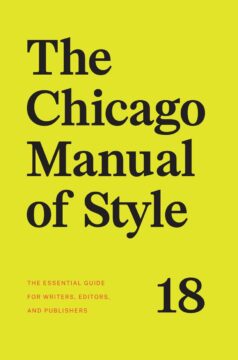 THE YEAR IS 1906. Theodore Roosevelt is in the White House. In New York, the newspapers are reporting on the political aspirations of William Randolph Hearst, unrest in Russia, and the latest dividends from US Steel. Scientific American is running articles about exploring the Sargasso Sea. In Boston, The New England Journal of Medicine is discussing new treatments for typhus and tuberculosis. Upton Sinclair’s new novel The Jungle, recently out from Doubleday, portrays the oppressive working conditions in Chicago’s meatpacking industry—Jack London calls it “the Uncle Tom’s Cabin of wage slavery”—and it’s taking the country by storm. In October, the Chicago White Sox play the Cubs in the country’s first intracity World Series, which the Sox go on to win (in a massive upset) four games to two.
THE YEAR IS 1906. Theodore Roosevelt is in the White House. In New York, the newspapers are reporting on the political aspirations of William Randolph Hearst, unrest in Russia, and the latest dividends from US Steel. Scientific American is running articles about exploring the Sargasso Sea. In Boston, The New England Journal of Medicine is discussing new treatments for typhus and tuberculosis. Upton Sinclair’s new novel The Jungle, recently out from Doubleday, portrays the oppressive working conditions in Chicago’s meatpacking industry—Jack London calls it “the Uncle Tom’s Cabin of wage slavery”—and it’s taking the country by storm. In October, the Chicago White Sox play the Cubs in the country’s first intracity World Series, which the Sox go on to win (in a massive upset) four games to two.
That fall, the University of Chicago Press also publishes the first edition of The Chicago Manual of Style. For 15-plus years, from the days of the press’s founding in 1890, the editors had been circulating guidelines and style sheets of best practices for their own editorial and production staff. Over the summer, they decide to see if there might be more general interest in, and demand for, these rules outside of the press, so that members of the broader public can better communicate with each other through print.
more here.
Enjoying the content on 3QD? Help keep us going by donating now.
Pedro Almodóvar’s Conflict Of Interests
Leo Robson at The New Statesman:
 In various ways, Pedro Almodóvar’s terrific new film represents a culmination or point of arrival. The Room Next Door, winner of the Golden Lion at the Venice Film Festival, marks the director’s first time working in English and telling a story set entirely outside Spain. It is also a clear admission – from a film-maker strongly associated with costume, production design and bodies – of an essential bookishness: his belief, expressed in his recently published collection of stories The Last Dream, that his vocation is “literary”, and it’s merely a quirk of fate that the bulk of his written output has been 22 screenplays, which he also directed. The film concerns two writers, Ingrid, a war reporter suffering from cancer (Tilda Swinton), and Martha (Julianne Moore), a novelist with whom Ingrid spends her final weeks. Though Almodóvar does away with many of the reference points in the source material, Sigrid Nunez’s novel What Are You Going Through, he introduces plenty of his own. The Room Next Door opens at a Manhattan bookshop, where Martha is doing a signing, and ends with a quotation from “The Dead” – and it isn’t the only bookshop, or mention of James Joyce.
In various ways, Pedro Almodóvar’s terrific new film represents a culmination or point of arrival. The Room Next Door, winner of the Golden Lion at the Venice Film Festival, marks the director’s first time working in English and telling a story set entirely outside Spain. It is also a clear admission – from a film-maker strongly associated with costume, production design and bodies – of an essential bookishness: his belief, expressed in his recently published collection of stories The Last Dream, that his vocation is “literary”, and it’s merely a quirk of fate that the bulk of his written output has been 22 screenplays, which he also directed. The film concerns two writers, Ingrid, a war reporter suffering from cancer (Tilda Swinton), and Martha (Julianne Moore), a novelist with whom Ingrid spends her final weeks. Though Almodóvar does away with many of the reference points in the source material, Sigrid Nunez’s novel What Are You Going Through, he introduces plenty of his own. The Room Next Door opens at a Manhattan bookshop, where Martha is doing a signing, and ends with a quotation from “The Dead” – and it isn’t the only bookshop, or mention of James Joyce.
more here.
Enjoying the content on 3QD? Help keep us going by donating now.
Pedro Almodóvar Breaks Down His Films
Enjoying the content on 3QD? Help keep us going by donating now.
Thursday, October 24, 2024
Notes From The Progress Studies Conference
Scott Alexander at Astral Codex Ten:
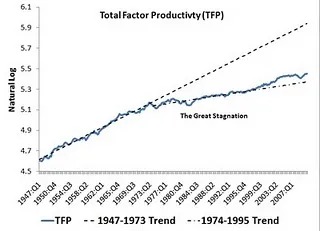 Tyler Cowen is an economics professor and blogger at Marginal Revolution. Patrick Collison is the billionaire founder of the online payments company Stripe. In 2019, they wrote an article calling for a discipline of Progress Studies, which would figure out what progress was and how to increase it. Later that year, tech entrepreneur Jason Crawford stepped up to spearhead the effort.
Tyler Cowen is an economics professor and blogger at Marginal Revolution. Patrick Collison is the billionaire founder of the online payments company Stripe. In 2019, they wrote an article calling for a discipline of Progress Studies, which would figure out what progress was and how to increase it. Later that year, tech entrepreneur Jason Crawford stepped up to spearhead the effort.
The immediate reaction was mostly negative. There were the usual gripes that “progress” was problematic because it could imply that some cultures/times/places/ideas were better than others. But there were also more specific objections: weren’t historians already studying progress? Wasn’t business academia already studying innovation? Are you really allowed to just invent a new field every time you think of something it would be cool to study?
It seems like you are. Five years later, Progress Studies has grown enough to hold its first conference. I got to attend, and it was great.
More here.
Enjoying the content on 3QD? Help keep us going by donating now.
Ready for a simple probability puzzle with a startling answer?
Ben Orlin at Math With Bad Drawings:
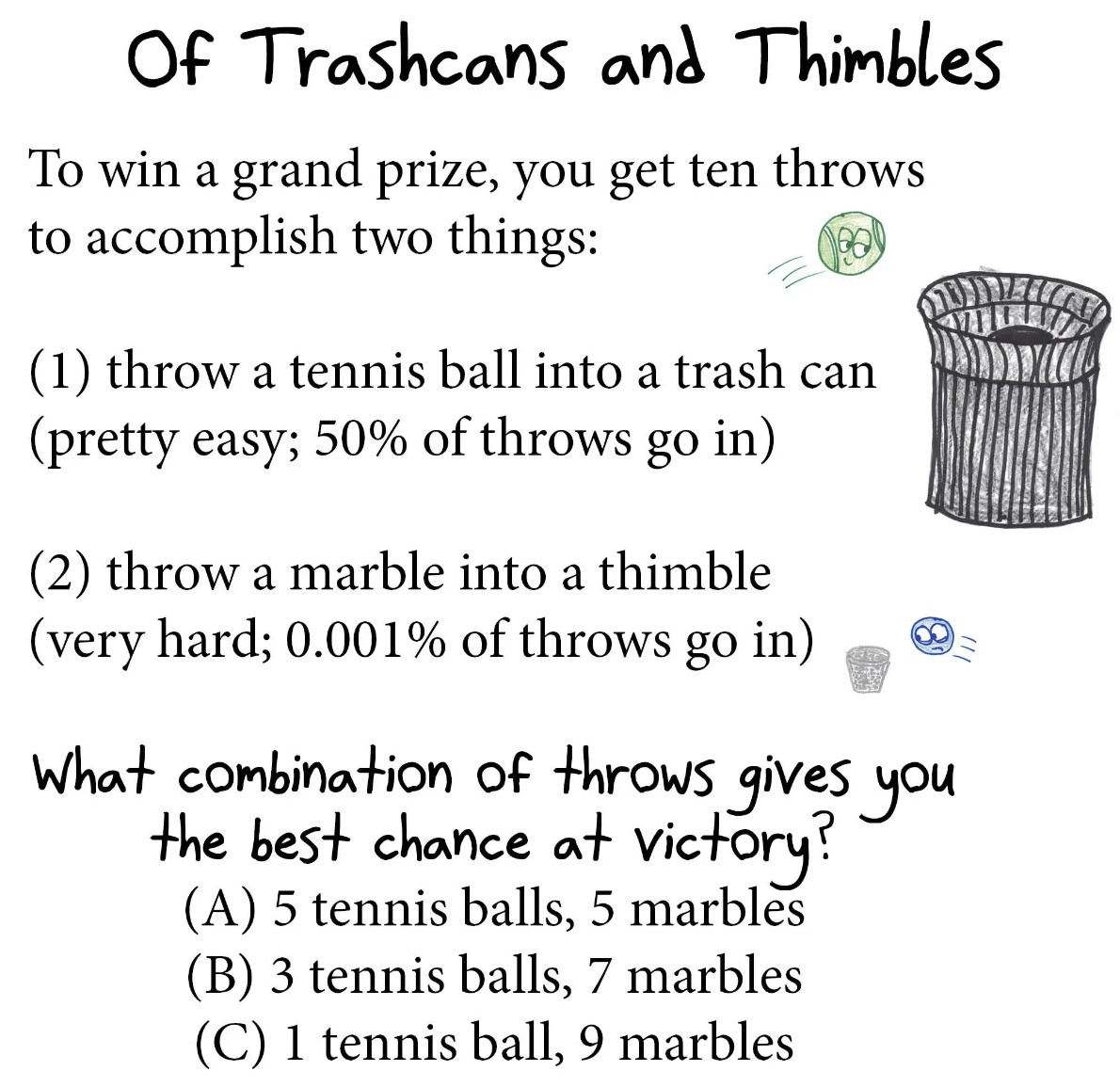
Answer and more here.
Enjoying the content on 3QD? Help keep us going by donating now.
